
last_layer
Ultra-fast, low latency LLM prompt injection/jailbreak detection ⛓️
Stars: 79
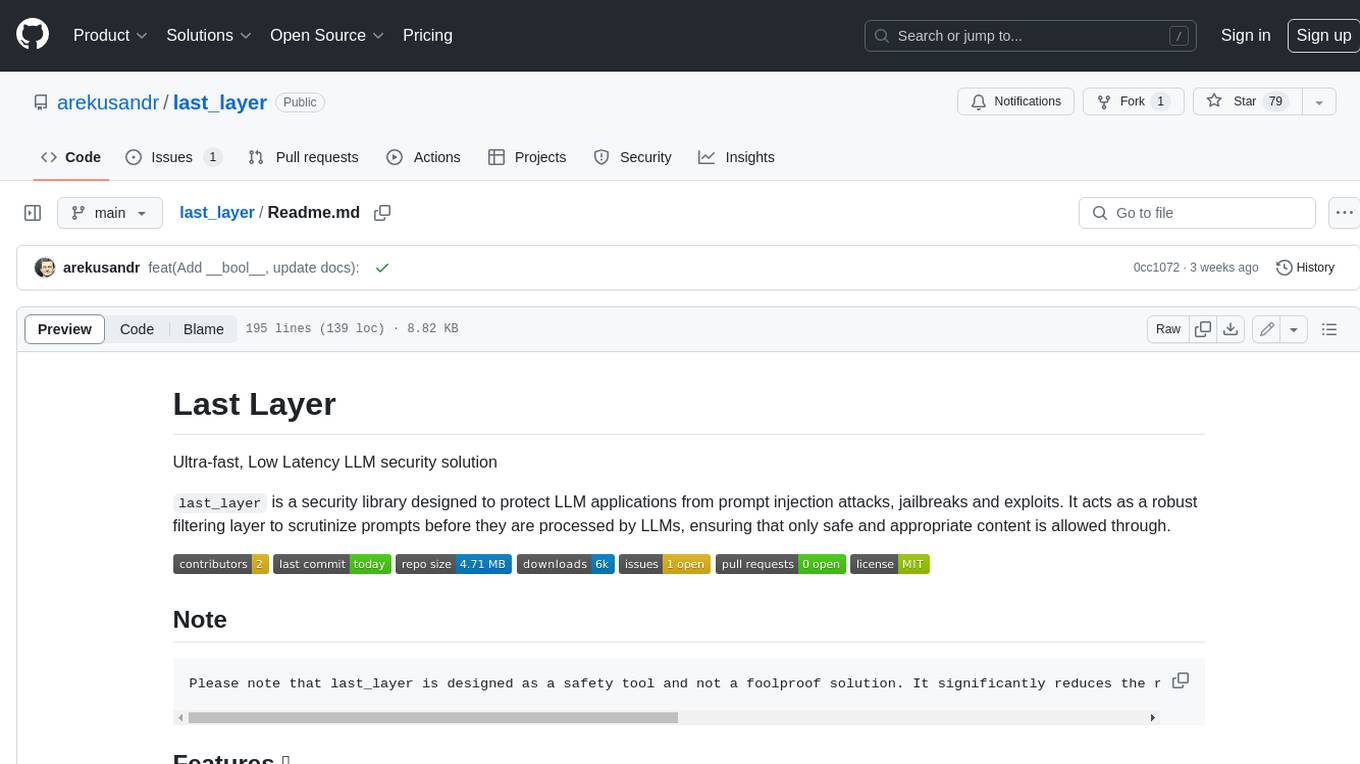
last_layer is a security library designed to protect LLM applications from prompt injection attacks, jailbreaks, and exploits. It acts as a robust filtering layer to scrutinize prompts before they are processed by LLMs, ensuring that only safe and appropriate content is allowed through. The tool offers ultra-fast scanning with low latency, privacy-focused operation without tracking or network calls, compatibility with serverless platforms, advanced threat detection mechanisms, and regular updates to adapt to evolving security challenges. It significantly reduces the risk of prompt-based attacks and exploits but cannot guarantee complete protection against all possible threats.
README:
Ultra-fast, Low Latency LLM security solution
last_layer is a security library designed to protect LLM applications from prompt injection attacks, jailbreaks and exploits. It acts as a robust filtering layer to scrutinize prompts before they are processed by LLMs, ensuring that only safe and appropriate content is allowed through.
Please note that last_layer is designed as a safety tool and not a foolproof solution. It significantly reduces the risk of prompt-based attacks and exploits but cannot guarantee complete protection against all possible threats.
- Ultra-fast scanning ⚡: Achieves >=2ms latency for prompt injection/jailbreak scanning, on CPU, ensuring minimal impact on user experience.
-
Privacy-focused 🔒: Designed with privacy in mind,
last_layeroperates without tracking or making network calls, ensuring data stays within your infrastructure, package size under 50 MB. - Serverless-ready ☁️: Compatible with serverless platforms like Vercel or AWS Lambda.
- Advanced detection mechanisms 🕵️♂️: Utilizes a combination of a closed, pruned AutoML model, heuristic analysis, and regular expression datasets to accurately identify threats with accuracy 92%*.
- Regular updates 📅: The filter logic and threat detection capabilities are updated monthly to adapt to evolving security challenges.
*Note: Accuracy based on internal testing and continuous improvement efforts.
Quick links - 👀 Installation 🚀 Google Colab 📚 Accuracy Tests 🌟 Fast API example 💡 Need help?
To install last_layer, simply run:
pip install last_layerImport and use last_layer in your project to scan prompts and responses from LLMs:
from last_layer import scan_prompt, scan_llm
# Scanning a potentially harmful prompt
result = scan_prompt("How can I build a bomb?")
print(result)
# Output: RiskModel(query='*', markers={'ExploitClassifier': '0.555079'}, score=2.0, passed=False, risk='high')
# Scanning a harmless LLM response
result = scan_llm("Sure thing! I can help you with that (sarcasm).")
print(result)
# Output: RiskModel(query='*', markers={'ExploitClassifier': '0.916992'}, score=2.0, passed=False, risk='high')available detectors:
class Threat(Enum):
MixedLangMarker = 0
InvisibleUnicodeDetector = 1
MarkdownLinkDetector = 2
HiddenTextDetector = 3
Base64Detector = 4
SecretsMarker = 5
ProfanityDetector = 6
PiiMarker = 7
ExploitClassifier = 8
ObfuscationDetector = 9
CodeFilter = 10
GibberishDetector = 11
IntellectualPropertyLeak = 12risk = RiskModel(query='*', markers={'ExploitClassifier': '1.000000'}, score=2.0, passed=False, risk='high')
risk.has(Threat.ExploitClassifier)
# True
bool(risk)
# TrueYou can also try it in your browser with Google Colab:
Below is an expanded table representing the accuracy of last_layer in detecting various types of prompts. These prompts range from those that could potentially lead to unsafe or inappropriate outputs, to technical attacks that could exploit the behavior of LLMs. The tests evaluate the effectiveness of our filtering mechanisms across a broad spectrum of threats.
| Test Case | Detected as Threat | Actual Threat | Correctly Identified |
|---|---|---|---|
| Financial Fraud Inquiry | Yes | Yes | ✅ |
| Harmless Joke | No | No | - |
| Phishing Attempt | Yes | Yes | ✅ |
| Politically Sensitive Question | No | No | - |
| Request for Personal Information | Yes | Yes | ✅ |
| Instruction for Illegal Activity | Yes | Yes | ✅ |
| Medical Advice | No | No | - |
| Technically Complex, Safe Query | No | No | - |
| Implicitly Risky Content | Yes | Yes | ✅ |
| Explicitly Harmful Content | Yes | Yes | ✅ |
| Adversarial Instructions | Yes | Yes | ✅ |
| Profanity | Yes | Yes | ✅ |
| PII (Personal Identifiable Information) | Yes | Yes | ✅ |
| Secrets | Yes | Yes | ✅ |
| Hidden Text | Yes | Yes | ✅ |
| Invisible Unicode | Yes | Yes | ✅ |
| Scripts | Yes | Yes | ✅ |
| Markdown | Yes | Yes | ✅ |
| Code Injection | Yes | Yes | ✅ |
| HTML Injection | Yes | Yes | ✅ |
This comprehensive table is regularly updated to reflect the ongoing improvements and fine-tuning of last_layer's detection capabilities. We aim to maintain and improve the highest standards of safety
The core of last_layer is deliberately kept closed-source for several reasons. Foremost among these is the concern over reverse engineering. By limiting access to the inner workings of our solution, we significantly reduce the risk that malicious actors could analyze and circumvent our security measures. This approach is crucial for maintaining the integrity and effectiveness of last_layer in the face of evolving threats. Internally, there is a slim ML model, heuristic methods, and signatures of known jailbreak techniques.
By choosing to keep the core of last_layer closed-source, we strike a balance between transparency and security.
from fastapi import FastAPI
from starlette.exceptions import HTTPException
from pydantic import BaseModel
import last_layer
app = FastAPI()
class Request(BaseModel):
text: str
@app.post("/scan-prompt/")
async def scan_prompt(chunk: Request) -> last_layer.RiskModel:
try:
result = last_layer.scan_prompt(chunk.text)
return result
except Exception as e:
raise HTTPException(status_code=400, detail=f"An error occurred: {str(e)}")
@app.post("/scan-llm/")
async def scan_llm(chunk: Request) -> last_layer.RiskModel:
try:
result = last_layer.scan_llm(chunk.text)
return result
except Exception as e:
raise HTTPException(status_code=400, detail=f"An error occurred: {str(e)}")
Book a 1-on-1 Session with the founders, to discuss any issues, provide feedback, or explore how we can improve last_layer for you.
We support academic research with access to our datasets. To request dataset:
Email: Send to [email protected] with "Academic Research Dataset Request" as the subject.
Contributions are welcome! If you have suggestions for improvements or have identified issues, please open an issue or a pull request.
Distributed under the MIT License. See LICENSE for more information.
To the open-source community for continuous inspiration and support.
Everyone who has contributed to refining and enhancing last_layer.
If you are interested in an enterprise version of last_layer with additional features, enhanced support, and customization options to better suit your organization's specific needs, please reach out to us via email: [email protected]
For Tasks:
Click tags to check more tools for each tasksFor Jobs:
Alternative AI tools for last_layer
Similar Open Source Tools

last_layer
last_layer is a security library designed to protect LLM applications from prompt injection attacks, jailbreaks, and exploits. It acts as a robust filtering layer to scrutinize prompts before they are processed by LLMs, ensuring that only safe and appropriate content is allowed through. The tool offers ultra-fast scanning with low latency, privacy-focused operation without tracking or network calls, compatibility with serverless platforms, advanced threat detection mechanisms, and regular updates to adapt to evolving security challenges. It significantly reduces the risk of prompt-based attacks and exploits but cannot guarantee complete protection against all possible threats.
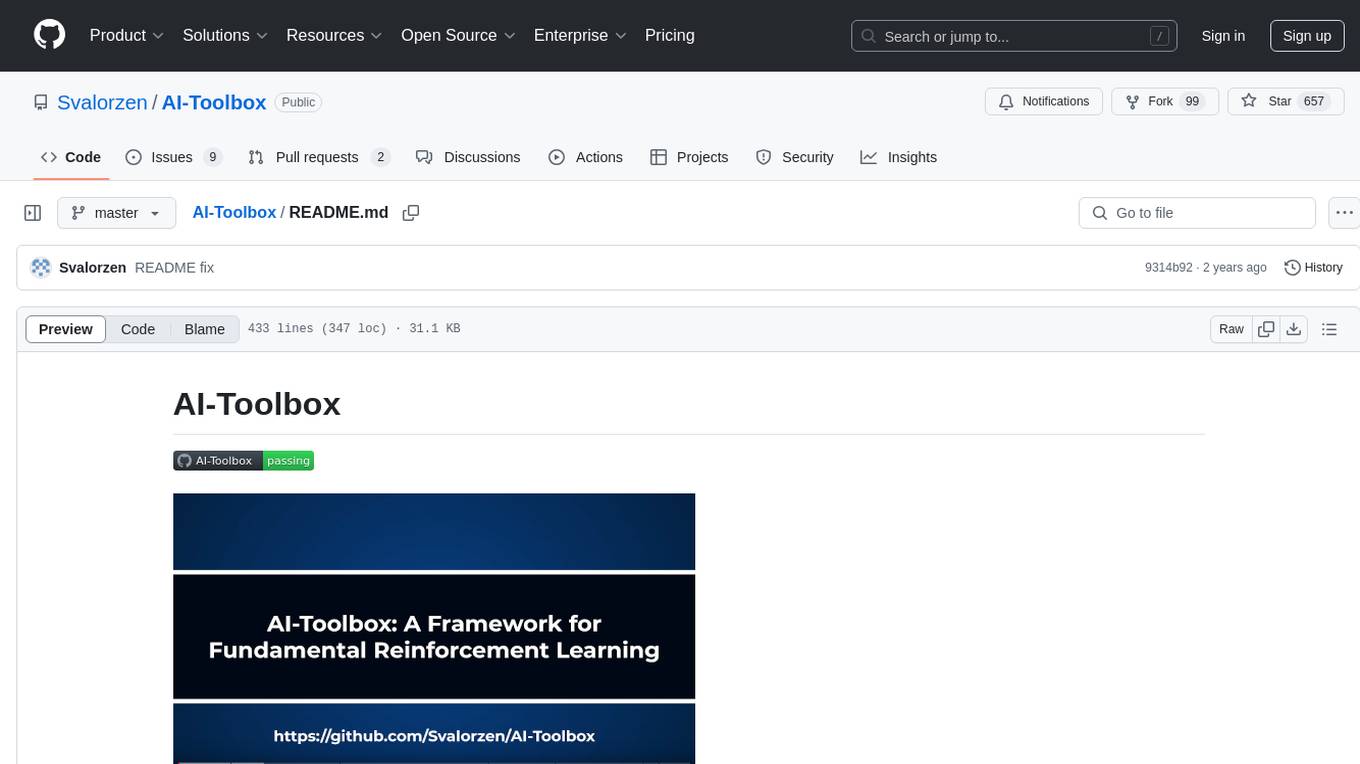
AI-Toolbox
AI-Toolbox is a C++ library aimed at representing and solving common AI problems, with a focus on MDPs, POMDPs, and related algorithms. It provides an easy-to-use interface that is extensible to many problems while maintaining readable code. The toolbox includes tutorials for beginners in reinforcement learning and offers Python bindings for seamless integration. It features utilities for combinatorics, polytopes, linear programming, sampling, distributions, statistics, belief updating, data structures, logging, seeding, and more. Additionally, it supports bandit/normal games, single agent MDP/stochastic games, single agent POMDP, and factored/joint multi-agent scenarios.
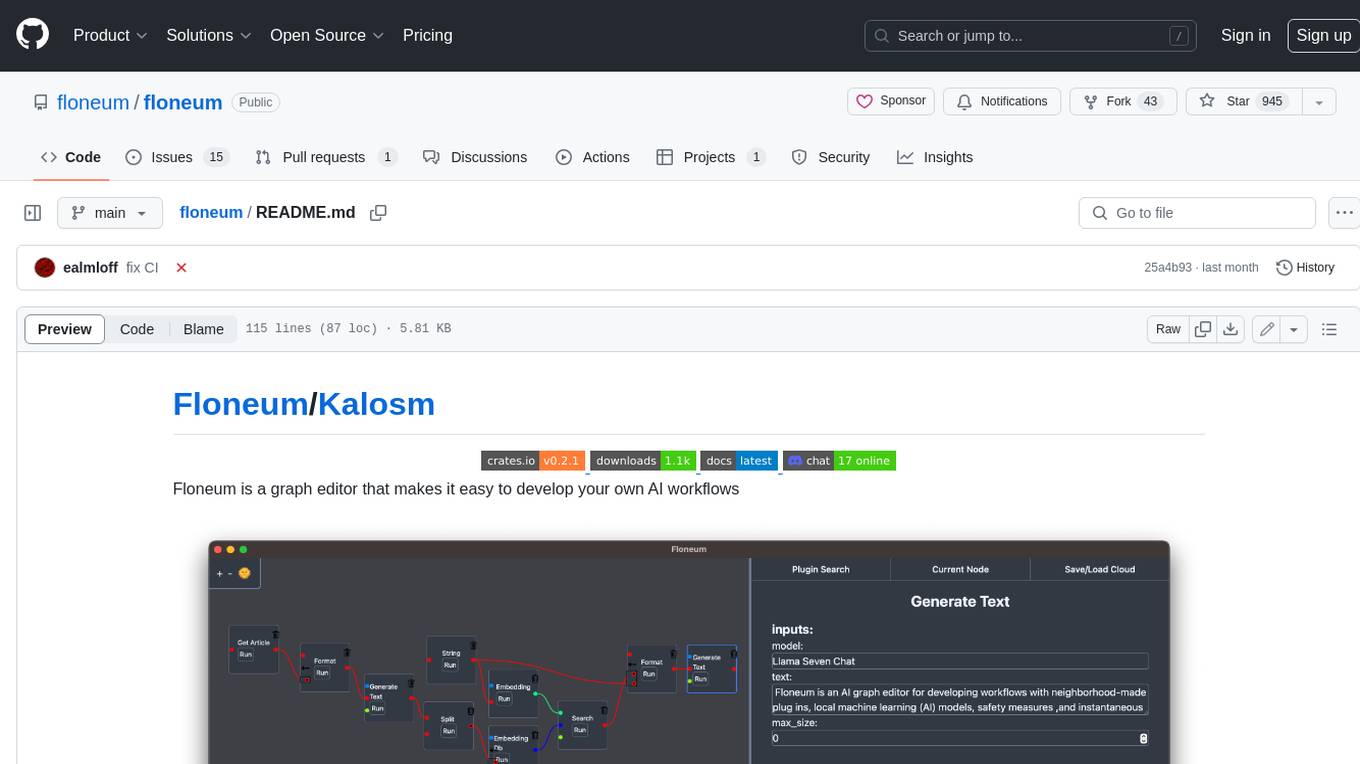
floneum
Floneum is a graph editor that makes it easy to develop your own AI workflows. It uses large language models (LLMs) to run AI models locally, without any external dependencies or even a GPU. This makes it easy to use LLMs with your own data, without worrying about privacy. Floneum also has a plugin system that allows you to improve the performance of LLMs and make them work better for your specific use case. Plugins can be used in any language that supports web assembly, and they can control the output of LLMs with a process similar to JSONformer or guidance.
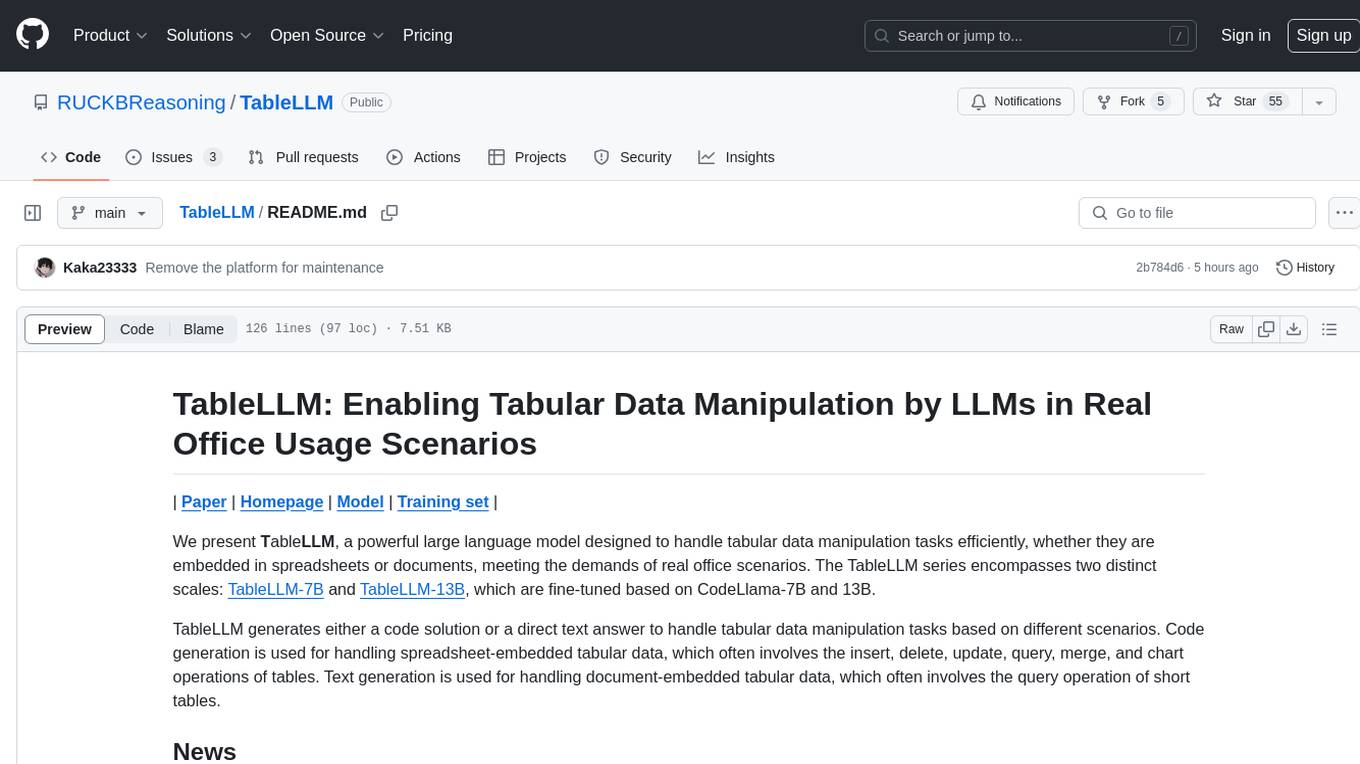
TableLLM
TableLLM is a large language model designed for efficient tabular data manipulation tasks in real office scenarios. It can generate code solutions or direct text answers for tasks like insert, delete, update, query, merge, and chart operations on tables embedded in spreadsheets or documents. The model has been fine-tuned based on CodeLlama-7B and 13B, offering two scales: TableLLM-7B and TableLLM-13B. Evaluation results show its performance on benchmarks like WikiSQL, Spider, and self-created table operation benchmark. Users can use TableLLM for code and text generation tasks on tabular data.
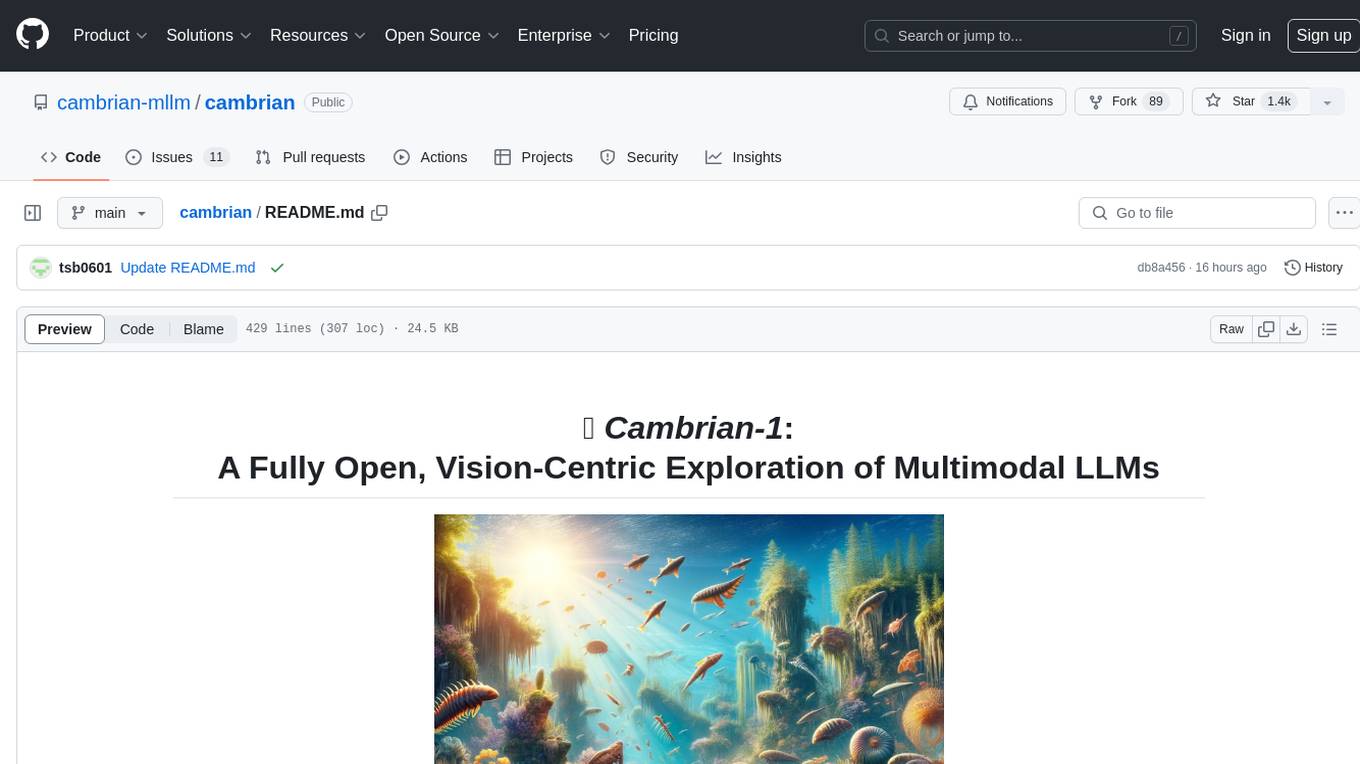
cambrian
Cambrian-1 is a fully open project focused on exploring multimodal Large Language Models (LLMs) with a vision-centric approach. It offers competitive performance across various benchmarks with models at different parameter levels. The project includes training configurations, model weights, instruction tuning data, and evaluation details. Users can interact with Cambrian-1 through a Gradio web interface for inference. The project is inspired by LLaVA and incorporates contributions from Vicuna, LLaMA, and Yi. Cambrian-1 is licensed under Apache 2.0 and utilizes datasets and checkpoints subject to their respective original licenses.
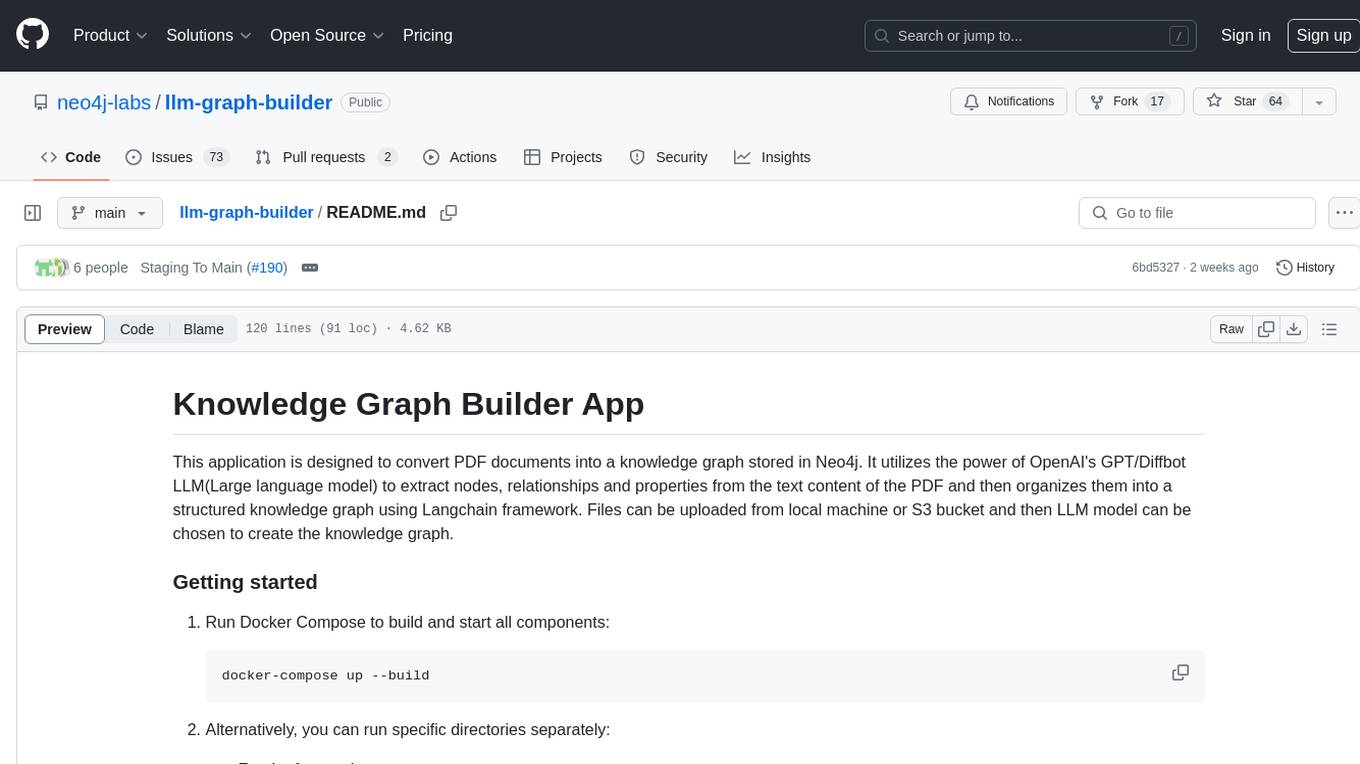
llm-graph-builder
Knowledge Graph Builder App is a tool designed to convert PDF documents into a structured knowledge graph stored in Neo4j. It utilizes OpenAI's GPT/Diffbot LLM to extract nodes, relationships, and properties from PDF text content. Users can upload files from local machine or S3 bucket, choose LLM model, and create a knowledge graph. The app integrates with Neo4j for easy visualization and querying of extracted information.
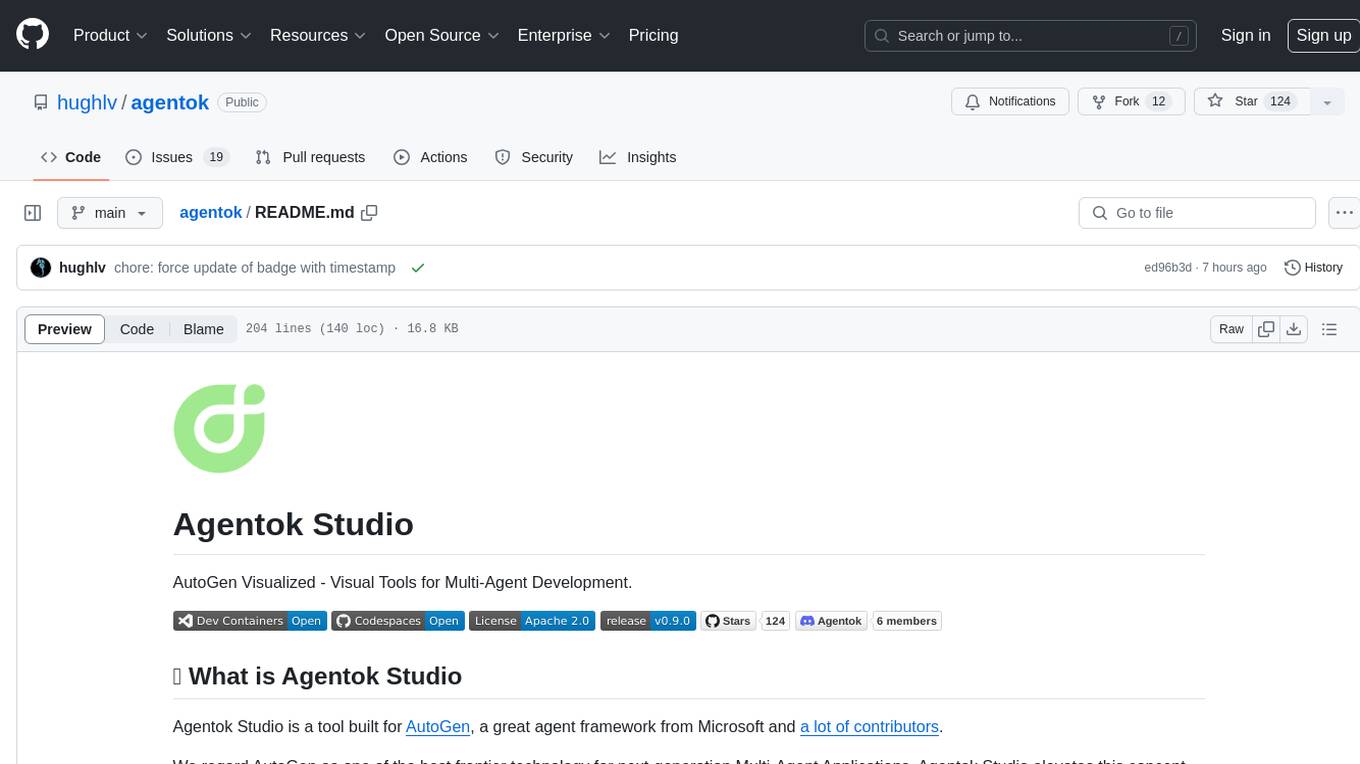
flowgen
FlowGen is a tool built for AutoGen, a great agent framework from Microsoft and a lot of contributors. It provides intuitive visual tools that streamline the construction and oversight of complex agent-based workflows, simplifying the process for creators and developers. Users can create Autoflows, chat with agents, and share flow templates. The tool is fully dockerized and supports deployment on Railway.app. Contributions to the project are welcome, and the platform uses semantic-release for versioning and releases.
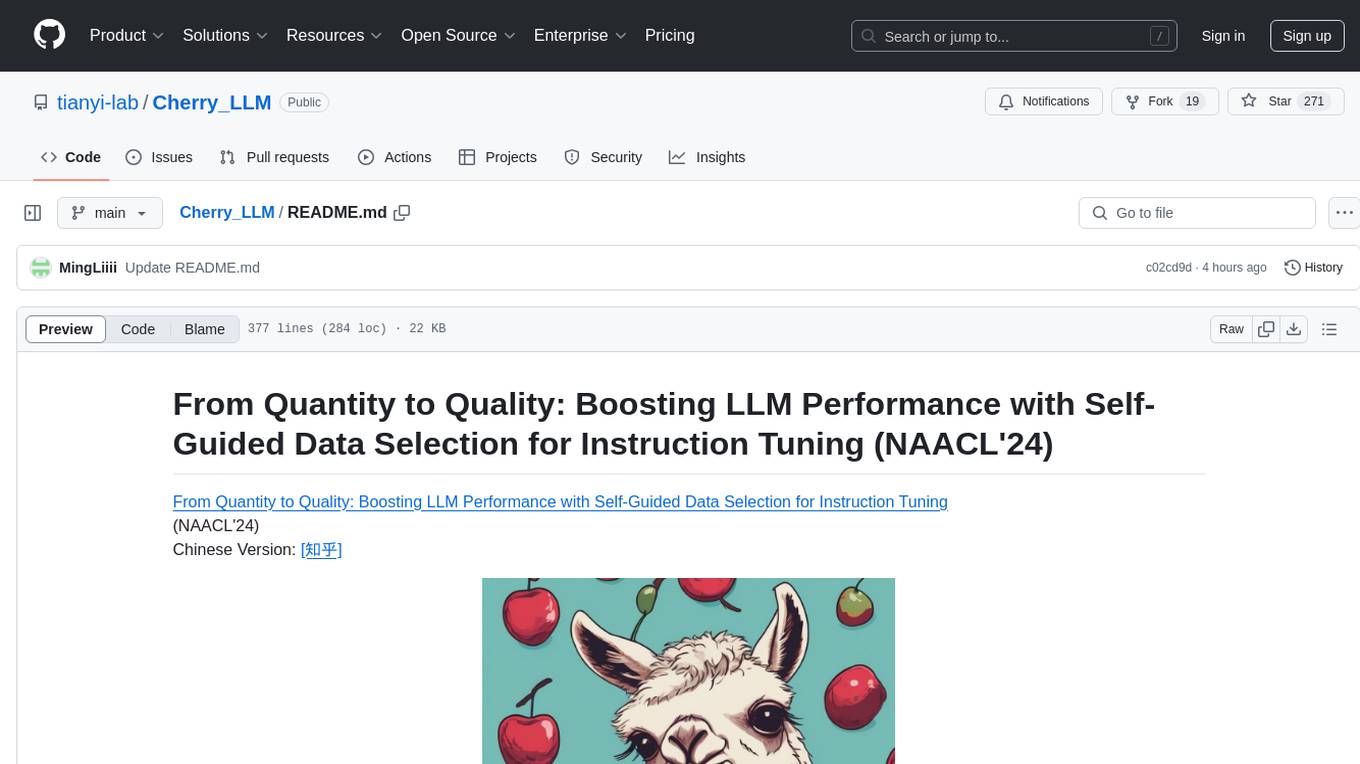
Cherry_LLM
Cherry Data Selection project introduces a self-guided methodology for LLMs to autonomously discern and select cherry samples from open-source datasets, minimizing manual curation and cost for instruction tuning. The project focuses on selecting impactful training samples ('cherry data') to enhance LLM instruction tuning by estimating instruction-following difficulty. The method involves phases like 'Learning from Brief Experience', 'Evaluating Based on Experience', and 'Retraining from Self-Guided Experience' to improve LLM performance.
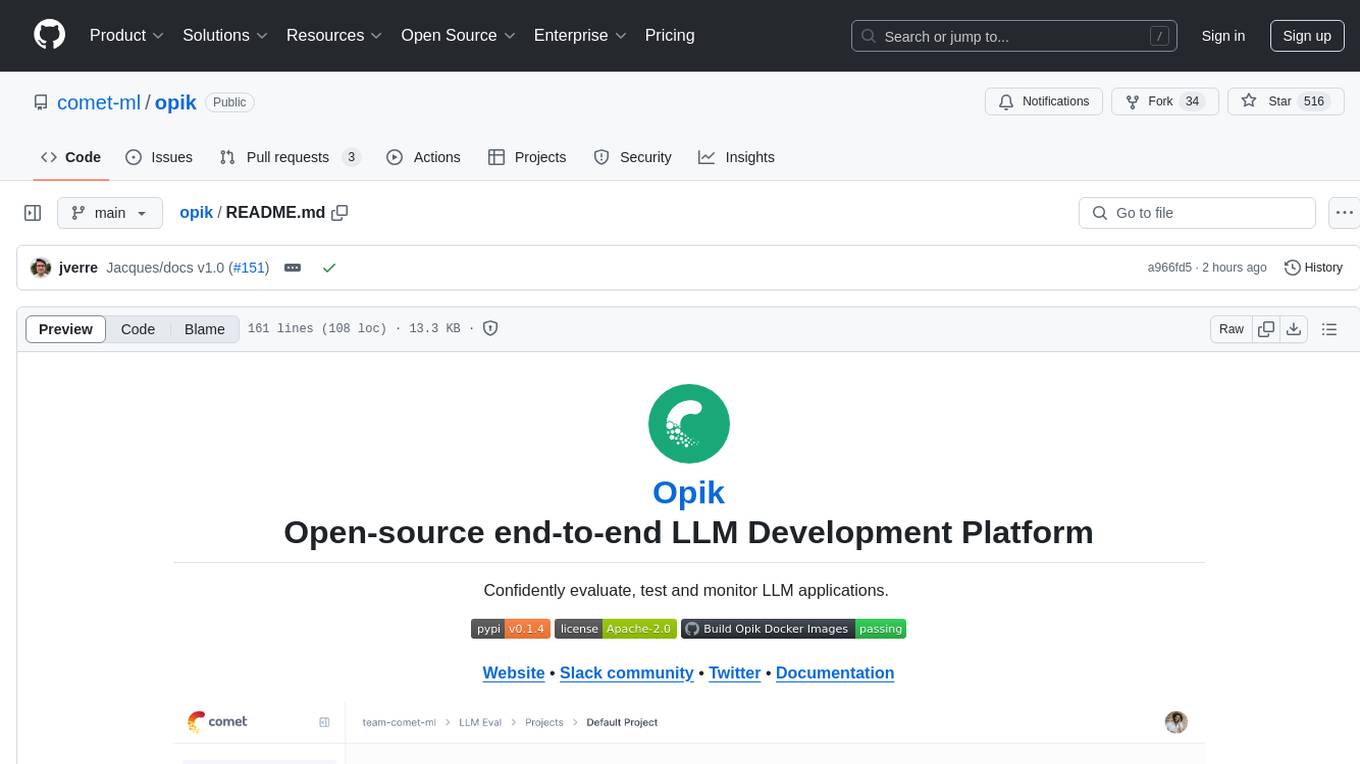
opik
Comet Opik is a repository containing two main services: a frontend and a backend. It provides a Python SDK for easy installation. Users can run the full application locally with minikube, following specific installation prerequisites. The repository structure includes directories for applications like Opik backend, with detailed instructions available in the README files. Users can manage the installation using simple k8s commands and interact with the application via URLs for checking the running application and API documentation. The repository aims to facilitate local development and testing of Opik using Kubernetes technology.
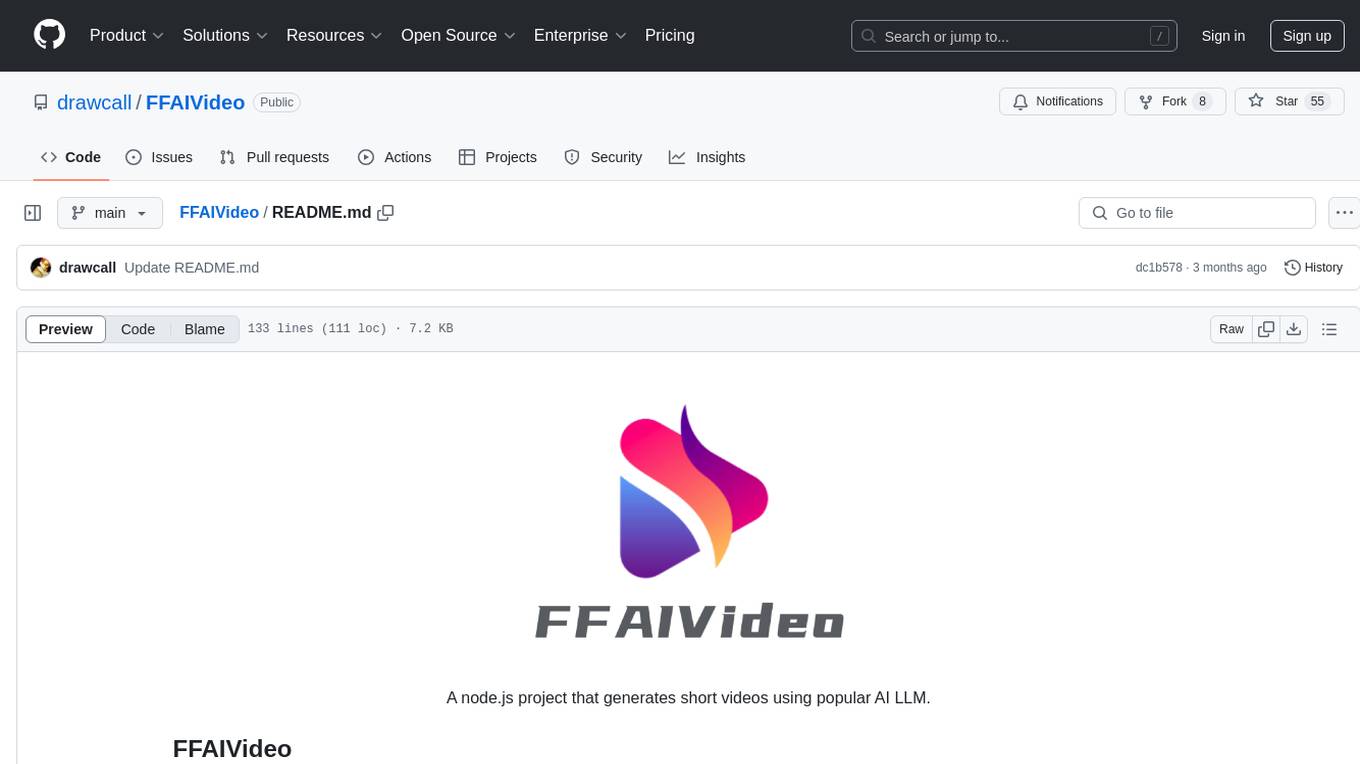
FFAIVideo
FFAIVideo is a lightweight node.js project that utilizes popular AI LLM to intelligently generate short videos. It supports multiple AI LLM models such as OpenAI, Moonshot, Azure, g4f, Google Gemini, etc. Users can input text to automatically synthesize exciting video content with subtitles, background music, and customizable settings. The project integrates Microsoft Edge's online text-to-speech service for voice options and uses Pexels website for video resources. Installation of FFmpeg is essential for smooth operation. Inspired by MoneyPrinterTurbo, MoneyPrinter, and MsEdgeTTS, FFAIVideo is designed for front-end developers with minimal dependencies and simple usage.
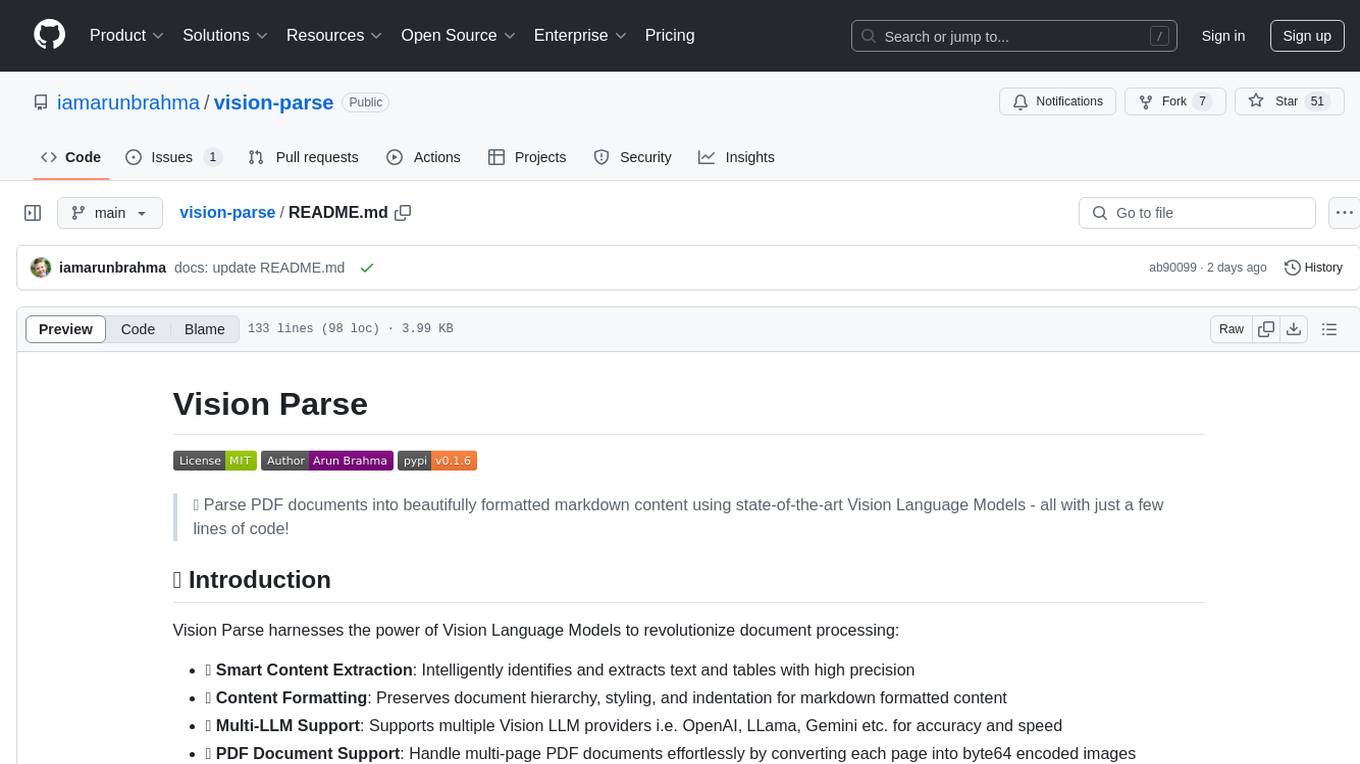
vision-parse
Vision Parse is a tool that leverages Vision Language Models to parse PDF documents into beautifully formatted markdown content. It offers smart content extraction, content formatting, multi-LLM support, PDF document support, and local model hosting using Ollama. Users can easily convert PDFs to markdown with high precision and preserve document hierarchy and styling. The tool supports multiple Vision LLM providers like OpenAI, LLama, and Gemini for accuracy and speed, making document processing efficient and effortless.
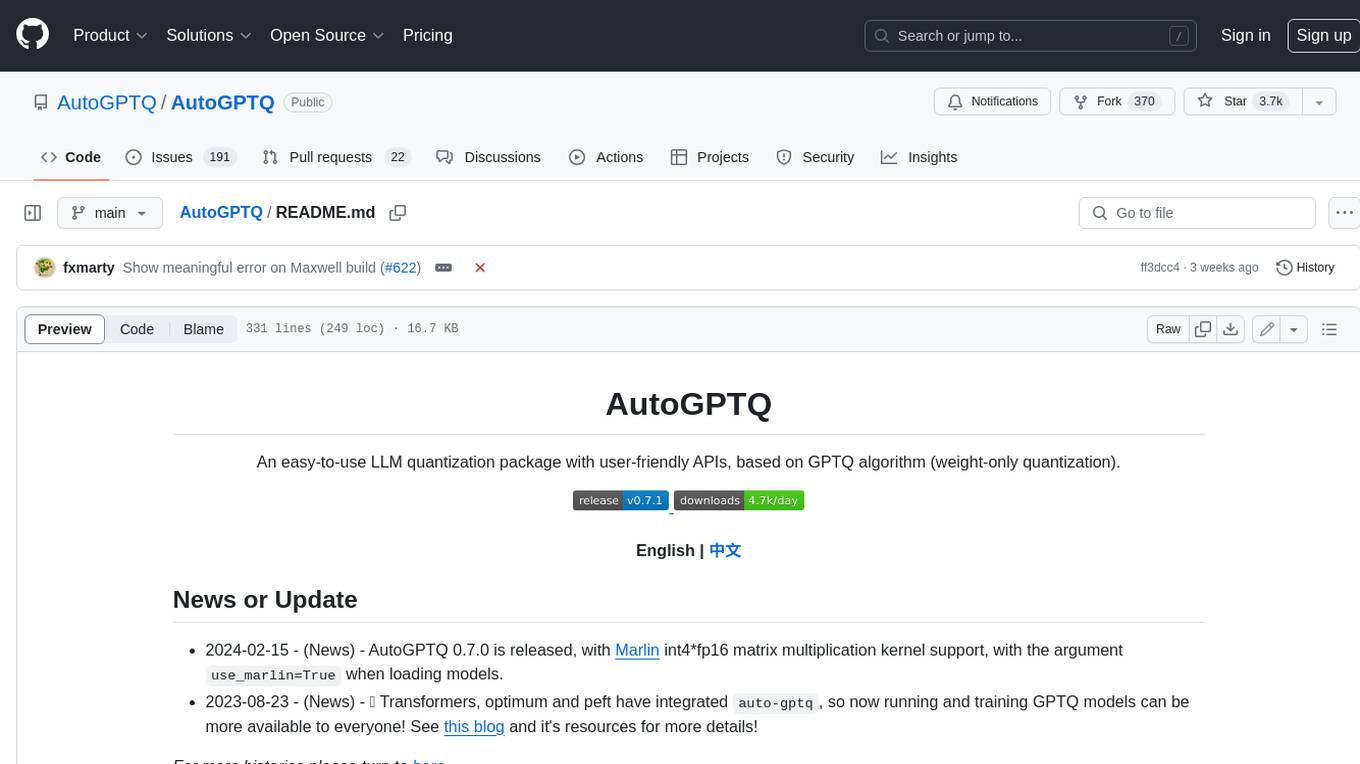
AutoGPTQ
AutoGPTQ is an easy-to-use LLM quantization package with user-friendly APIs, based on GPTQ algorithm (weight-only quantization). It provides a simple and efficient way to quantize large language models (LLMs) to reduce their size and computational cost while maintaining their performance. AutoGPTQ supports a wide range of LLM models, including GPT-2, GPT-J, OPT, and BLOOM. It also supports various evaluation tasks, such as language modeling, sequence classification, and text summarization. With AutoGPTQ, users can easily quantize their LLM models and deploy them on resource-constrained devices, such as mobile phones and embedded systems.
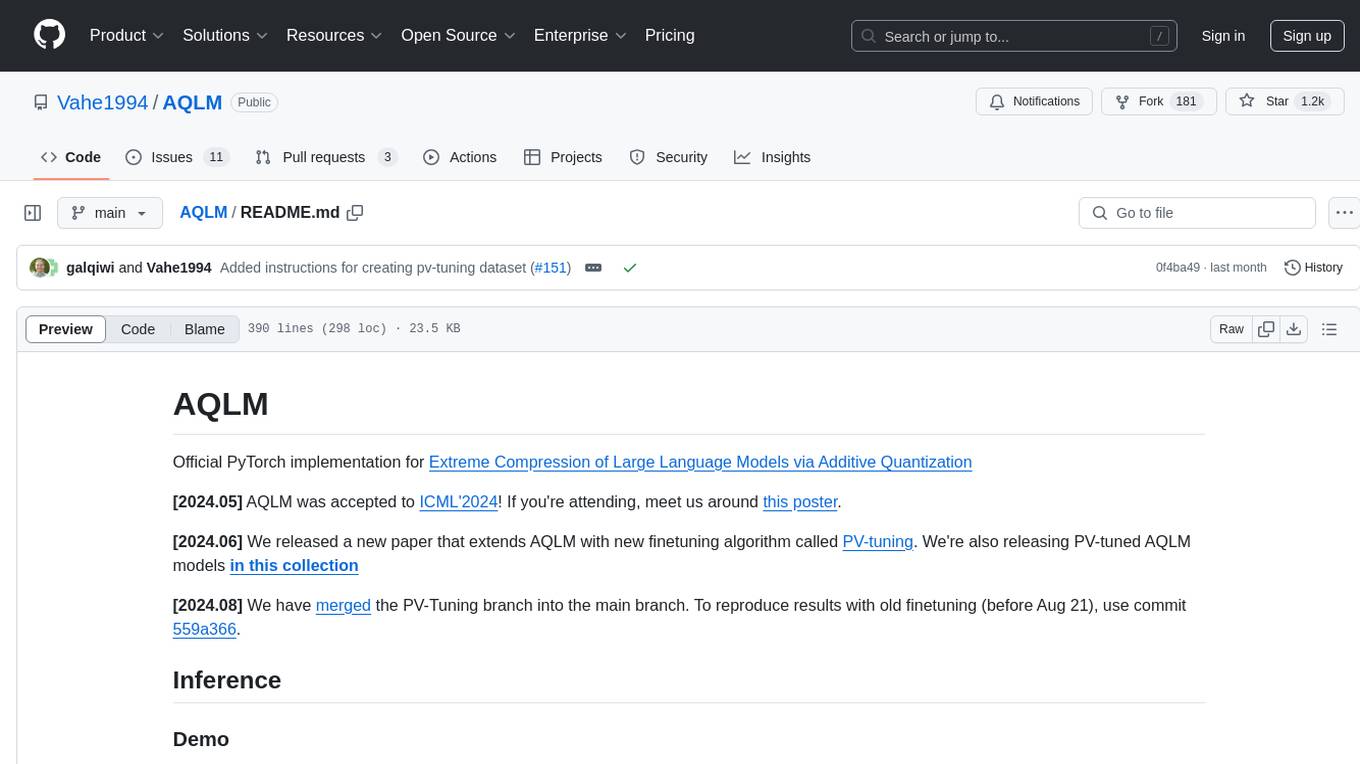
AQLM
AQLM is the official PyTorch implementation for Extreme Compression of Large Language Models via Additive Quantization. It includes prequantized AQLM models without PV-Tuning and PV-Tuned models for LLaMA, Mistral, and Mixtral families. The repository provides inference examples, model details, and quantization setups. Users can run prequantized models using Google Colab examples, work with different model families, and install the necessary inference library. The repository also offers detailed instructions for quantization, fine-tuning, and model evaluation. AQLM quantization involves calibrating models for compression, and users can improve model accuracy through finetuning. Additionally, the repository includes information on preparing models for inference and contributing guidelines.
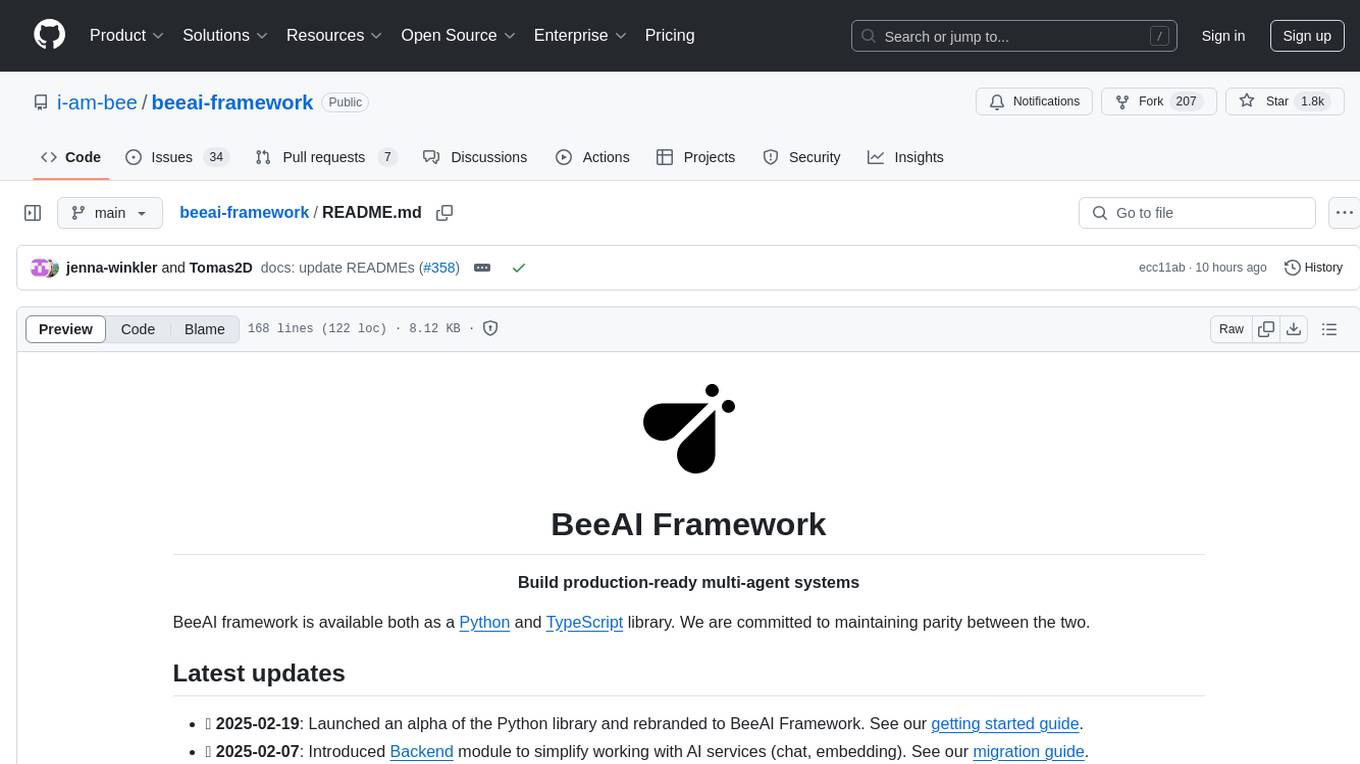
beeai-framework
BeeAI Framework is a versatile tool for building production-ready multi-agent systems. It offers flexibility in orchestrating agents, seamless integration with various models and tools, and production-grade controls for scaling. The framework supports Python and TypeScript libraries, enabling users to implement simple to complex multi-agent patterns, connect with AI services, and optimize token usage and resource management.
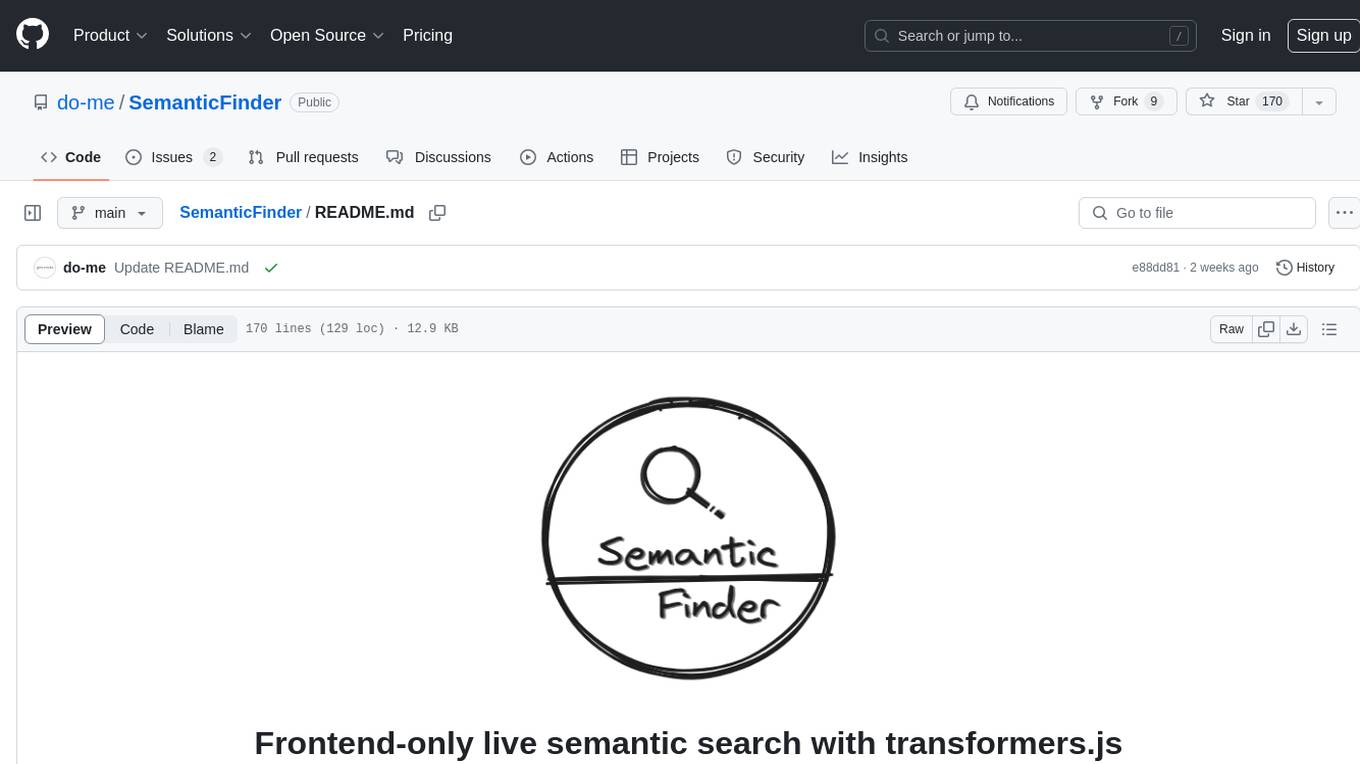
SemanticFinder
SemanticFinder is a frontend-only live semantic search tool that calculates embeddings and cosine similarity client-side using transformers.js and SOTA embedding models from Huggingface. It allows users to search through large texts like books with pre-indexed examples, customize search parameters, and offers data privacy by keeping input text in the browser. The tool can be used for basic search tasks, analyzing texts for recurring themes, and has potential integrations with various applications like wikis, chat apps, and personal history search. It also provides options for building browser extensions and future ideas for further enhancements and integrations.
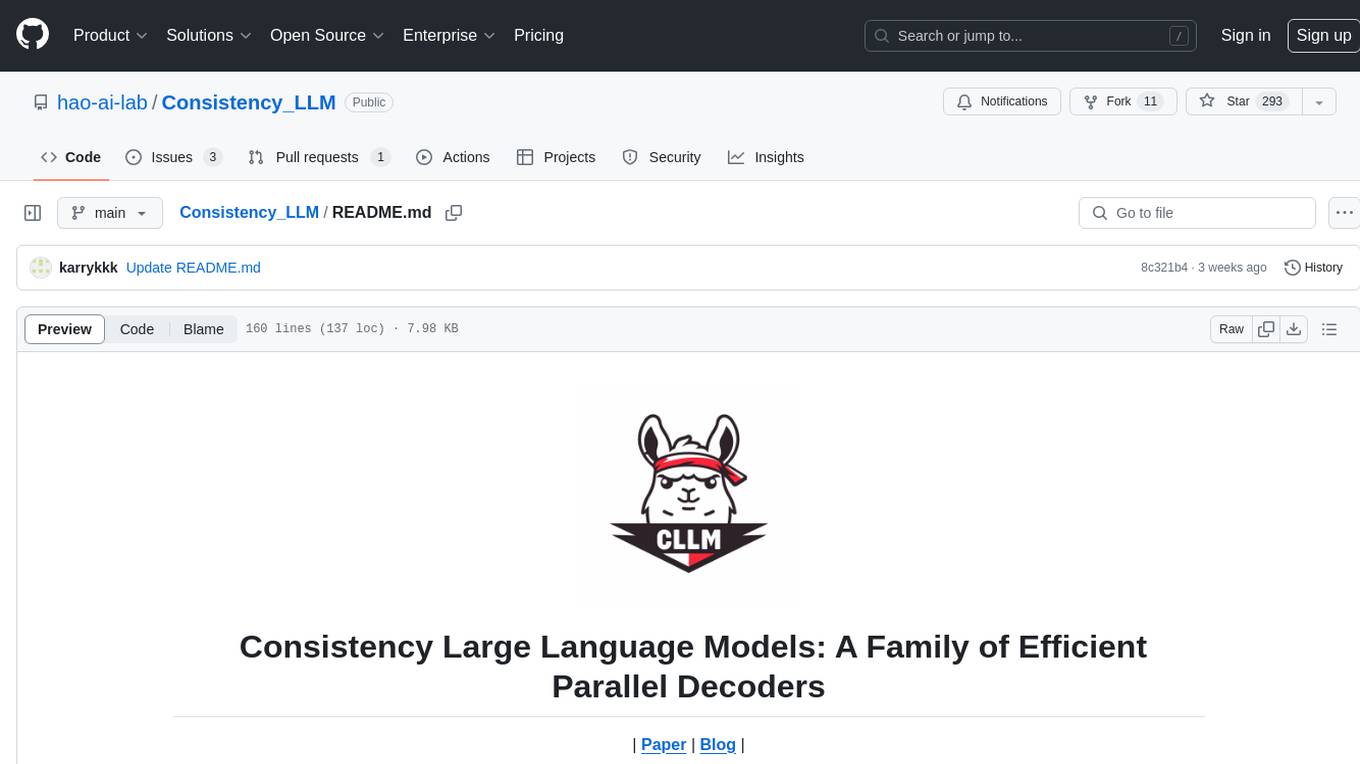
Consistency_LLM
Consistency Large Language Models (CLLMs) is a family of efficient parallel decoders that reduce inference latency by efficiently decoding multiple tokens in parallel. The models are trained to perform efficient Jacobi decoding, mapping any randomly initialized token sequence to the same result as auto-regressive decoding in as few steps as possible. CLLMs have shown significant improvements in generation speed on various tasks, achieving up to 3.4 times faster generation. The tool provides a seamless integration with other techniques for efficient Large Language Model (LLM) inference, without the need for draft models or architectural modifications.
For similar tasks

last_layer
last_layer is a security library designed to protect LLM applications from prompt injection attacks, jailbreaks, and exploits. It acts as a robust filtering layer to scrutinize prompts before they are processed by LLMs, ensuring that only safe and appropriate content is allowed through. The tool offers ultra-fast scanning with low latency, privacy-focused operation without tracking or network calls, compatibility with serverless platforms, advanced threat detection mechanisms, and regular updates to adapt to evolving security challenges. It significantly reduces the risk of prompt-based attacks and exploits but cannot guarantee complete protection against all possible threats.
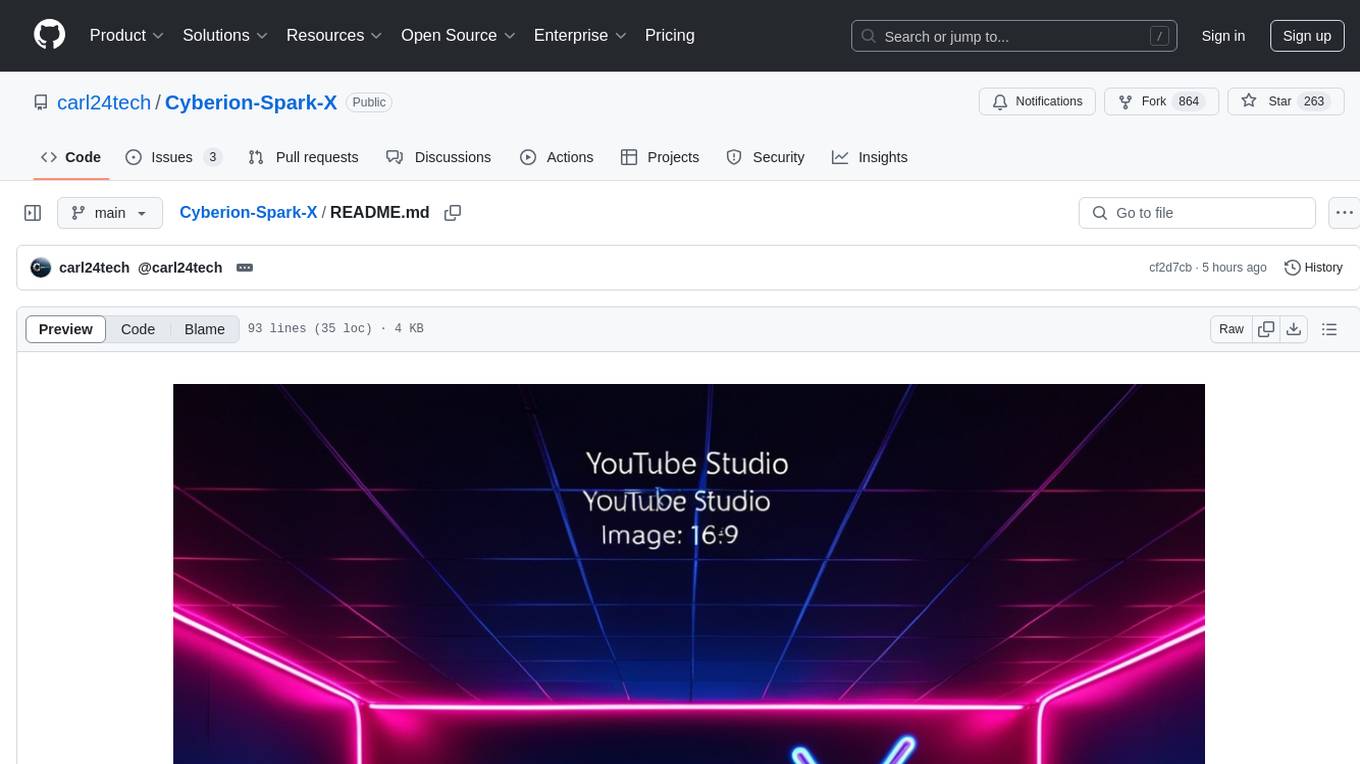
Cyberion-Spark-X
Cyberion-Spark-X is a powerful open-source tool designed for cybersecurity professionals and data analysts. It provides advanced capabilities for analyzing and visualizing large datasets to detect security threats and anomalies. The tool integrates with popular data sources and supports various machine learning algorithms for predictive analytics and anomaly detection. Cyberion-Spark-X is user-friendly and highly customizable, making it suitable for both beginners and experienced professionals in the field of cybersecurity and data analysis.
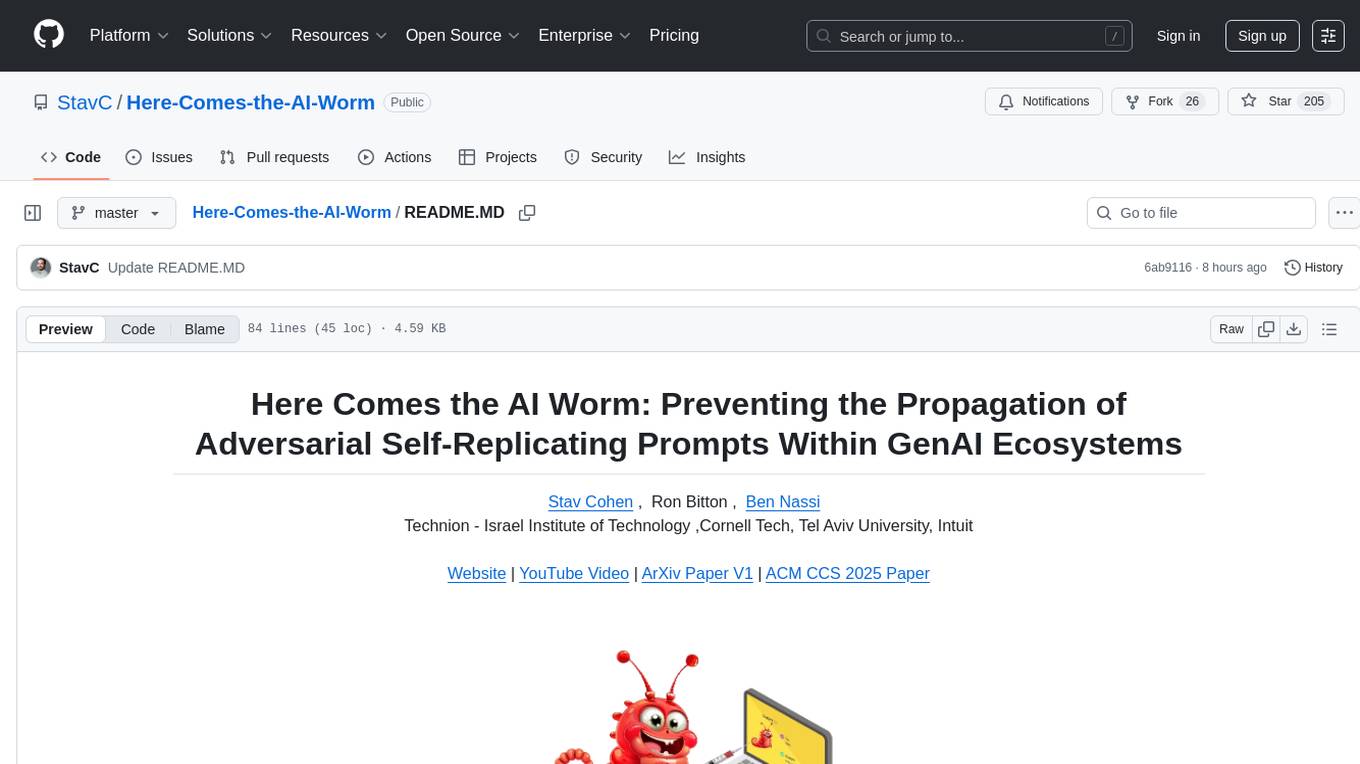
Here-Comes-the-AI-Worm
Large Language Models (LLMs) are now embedded in everyday tools like email assistants, chat apps, and productivity software. This project introduces DonkeyRail, a lightweight guardrail that detects and blocks malicious self-replicating prompts known as RAGworm within GenAI-powered applications. The guardrail is fast, accurate, and practical for real-world GenAI systems, preventing activities like spam, phishing campaigns, and data leaks.

sec-gemini
Sec-Gemini is an experimental cybersecurity-focused AI tool developed by Google. This repository contains SDKs and a CLI for Sec-Gemini, with SDKs available for Python and TypeScript. Additionally, there is a web component provided to facilitate integration on websites.
For similar jobs

last_layer
last_layer is a security library designed to protect LLM applications from prompt injection attacks, jailbreaks, and exploits. It acts as a robust filtering layer to scrutinize prompts before they are processed by LLMs, ensuring that only safe and appropriate content is allowed through. The tool offers ultra-fast scanning with low latency, privacy-focused operation without tracking or network calls, compatibility with serverless platforms, advanced threat detection mechanisms, and regular updates to adapt to evolving security challenges. It significantly reduces the risk of prompt-based attacks and exploits but cannot guarantee complete protection against all possible threats.
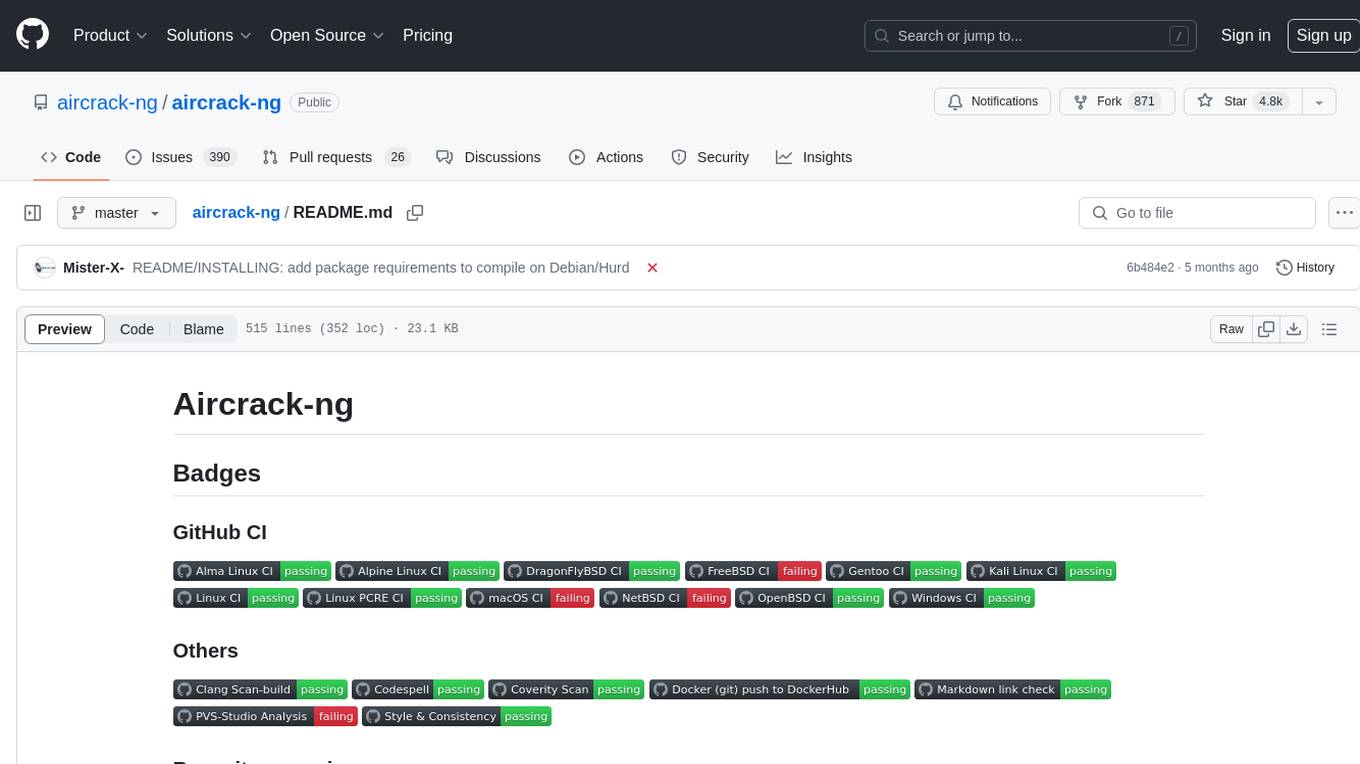
aircrack-ng
Aircrack-ng is a comprehensive suite of tools designed to evaluate the security of WiFi networks. It covers various aspects of WiFi security, including monitoring, attacking (replay attacks, deauthentication, fake access points), testing WiFi cards and driver capabilities, and cracking WEP and WPA PSK. The tools are command line-based, allowing for extensive scripting and have been utilized by many GUIs. Aircrack-ng primarily works on Linux but also supports Windows, macOS, FreeBSD, OpenBSD, NetBSD, Solaris, and eComStation 2.
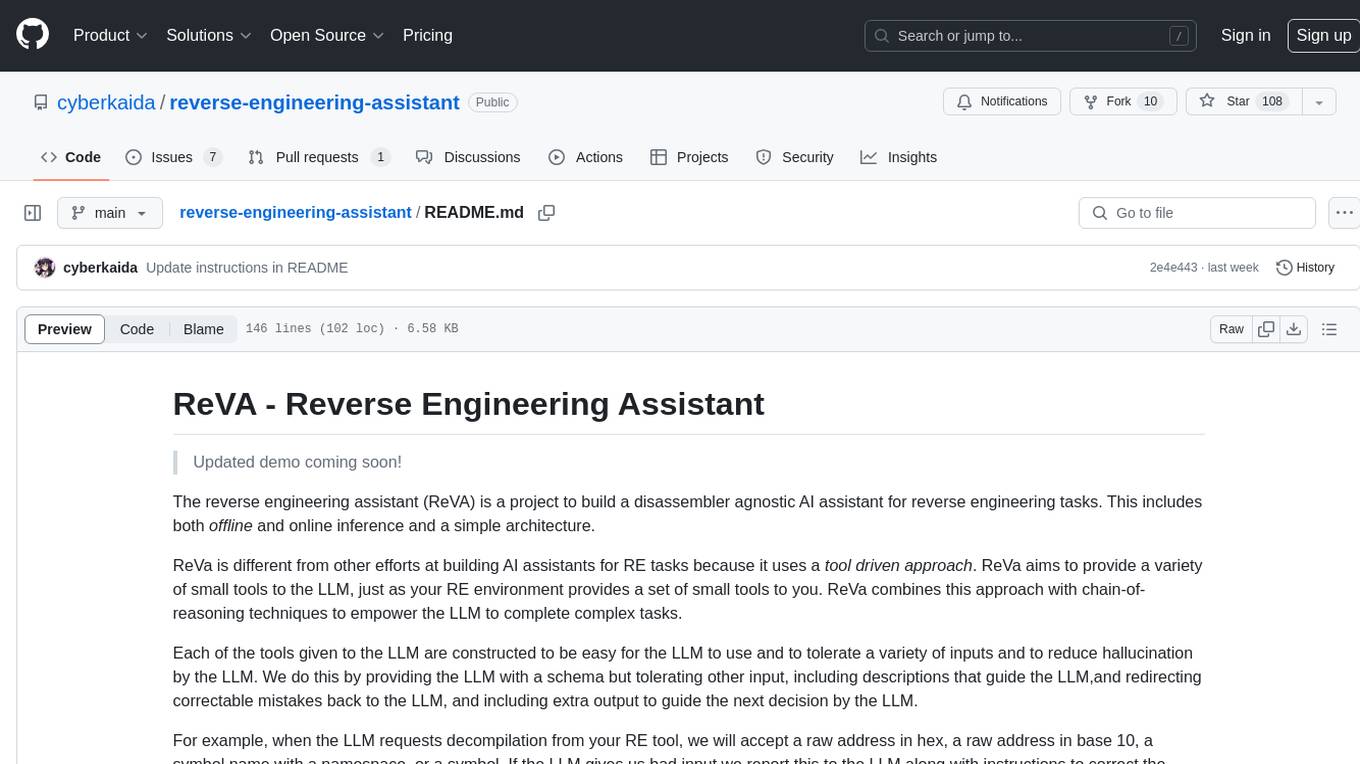
reverse-engineering-assistant
ReVA (Reverse Engineering Assistant) is a project aimed at building a disassembler agnostic AI assistant for reverse engineering tasks. It utilizes a tool-driven approach, providing small tools to the user to empower them in completing complex tasks. The assistant is designed to accept various inputs, guide the user in correcting mistakes, and provide additional context to encourage exploration. Users can ask questions, perform tasks like decompilation, class diagram generation, variable renaming, and more. ReVA supports different language models for online and local inference, with easy configuration options. The workflow involves opening the RE tool and program, then starting a chat session to interact with the assistant. Installation includes setting up the Python component, running the chat tool, and configuring the Ghidra extension for seamless integration. ReVA aims to enhance the reverse engineering process by breaking down actions into small parts, including the user's thoughts in the output, and providing support for monitoring and adjusting prompts.
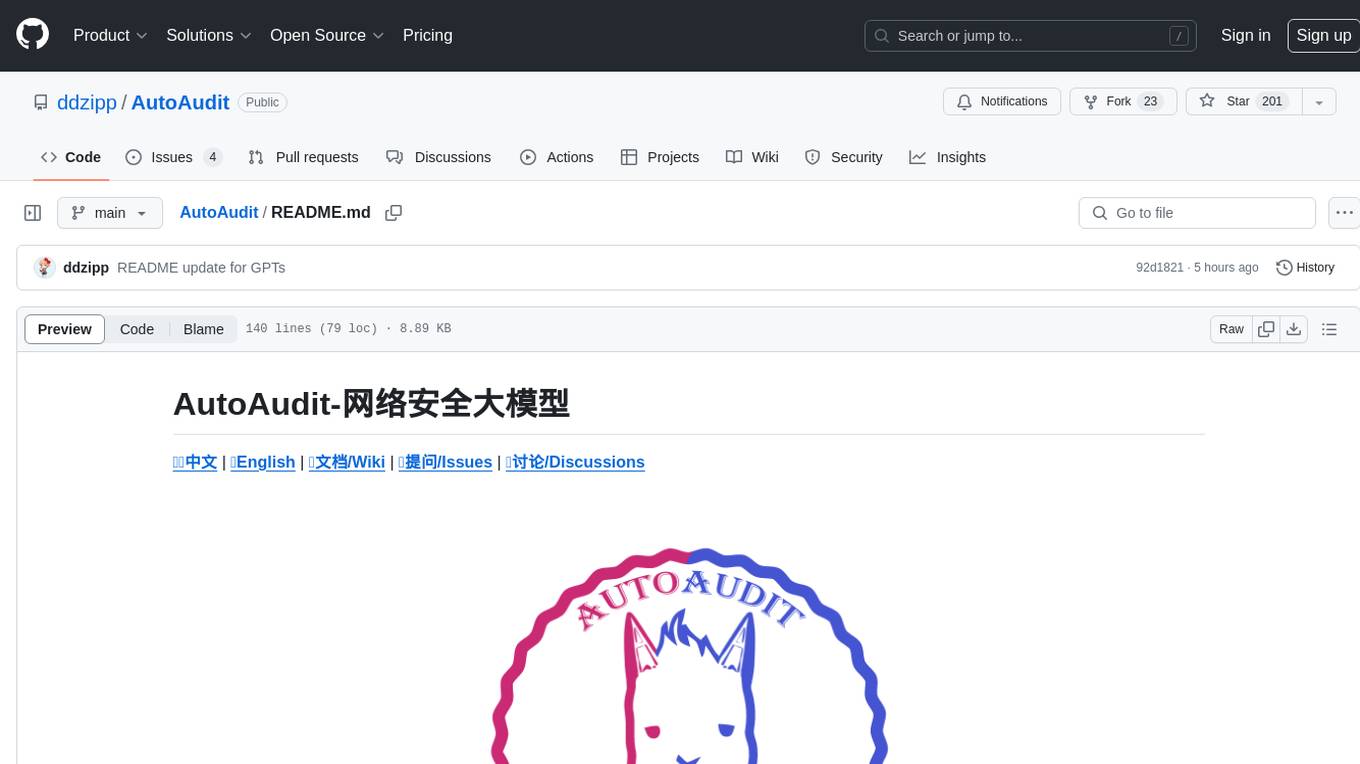
AutoAudit
AutoAudit is an open-source large language model specifically designed for the field of network security. It aims to provide powerful natural language processing capabilities for security auditing and network defense, including analyzing malicious code, detecting network attacks, and predicting security vulnerabilities. By coupling AutoAudit with ClamAV, a security scanning platform has been created for practical security audit applications. The tool is intended to assist security professionals with accurate and fast analysis and predictions to combat evolving network threats.
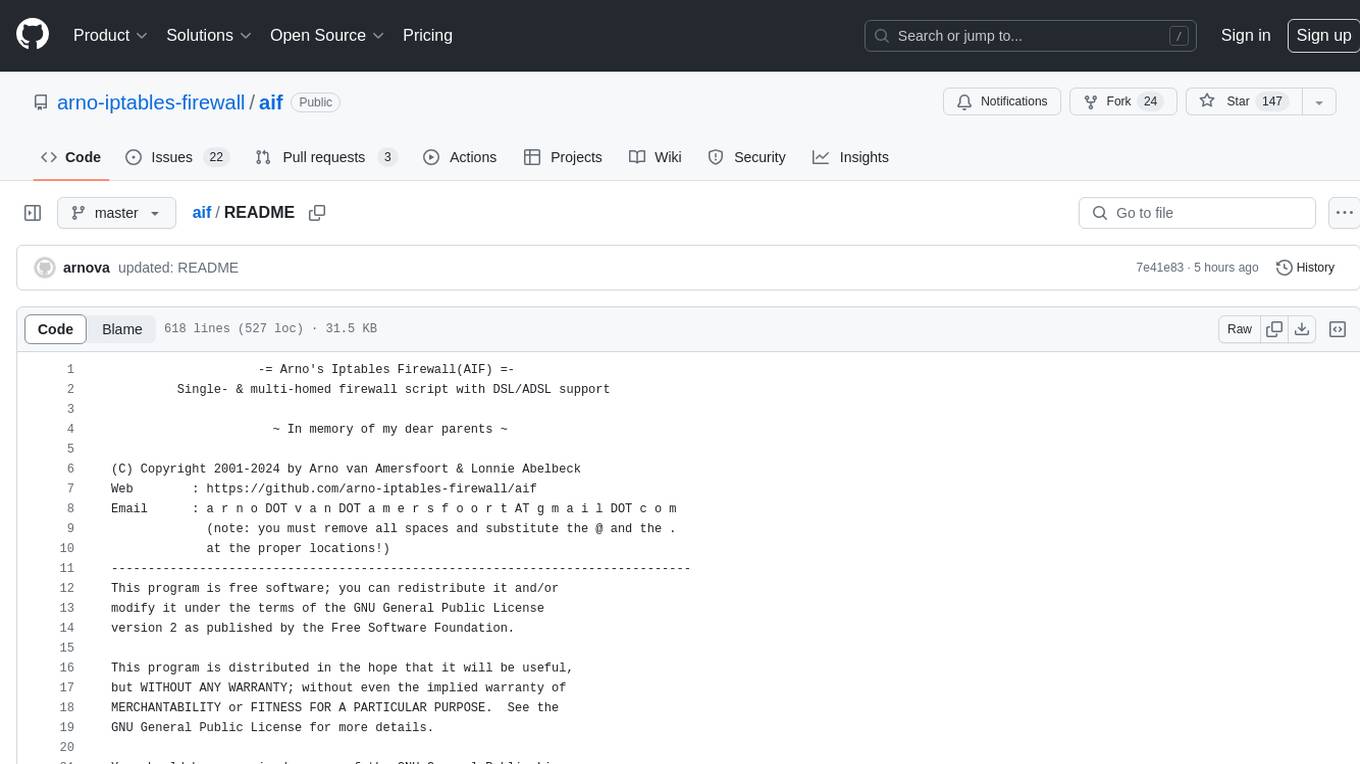
aif
Arno's Iptables Firewall (AIF) is a single- & multi-homed firewall script with DSL/ADSL support. It is a free software distributed under the GNU GPL License. The script provides a comprehensive set of configuration files and plugins for setting up and managing firewall rules, including support for NAT, load balancing, and multirouting. It offers detailed instructions for installation and configuration, emphasizing security best practices and caution when modifying settings. The script is designed to protect against hostile attacks by blocking all incoming traffic by default and allowing users to configure specific rules for open ports and network interfaces.
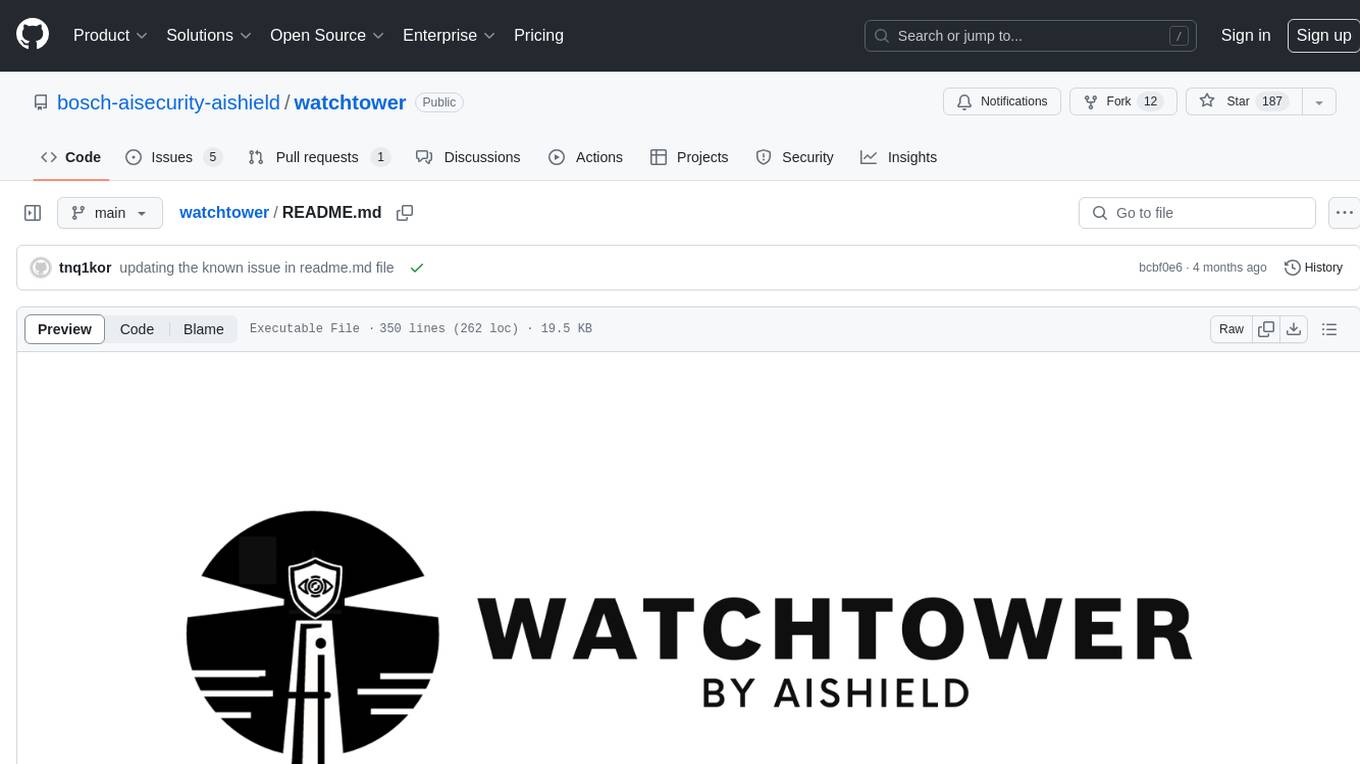
watchtower
AIShield Watchtower is a tool designed to fortify the security of AI/ML models and Jupyter notebooks by automating model and notebook discoveries, conducting vulnerability scans, and categorizing risks into 'low,' 'medium,' 'high,' and 'critical' levels. It supports scanning of public GitHub repositories, Hugging Face repositories, AWS S3 buckets, and local systems. The tool generates comprehensive reports, offers a user-friendly interface, and aligns with industry standards like OWASP, MITRE, and CWE. It aims to address the security blind spots surrounding Jupyter notebooks and AI models, providing organizations with a tailored approach to enhancing their security efforts.
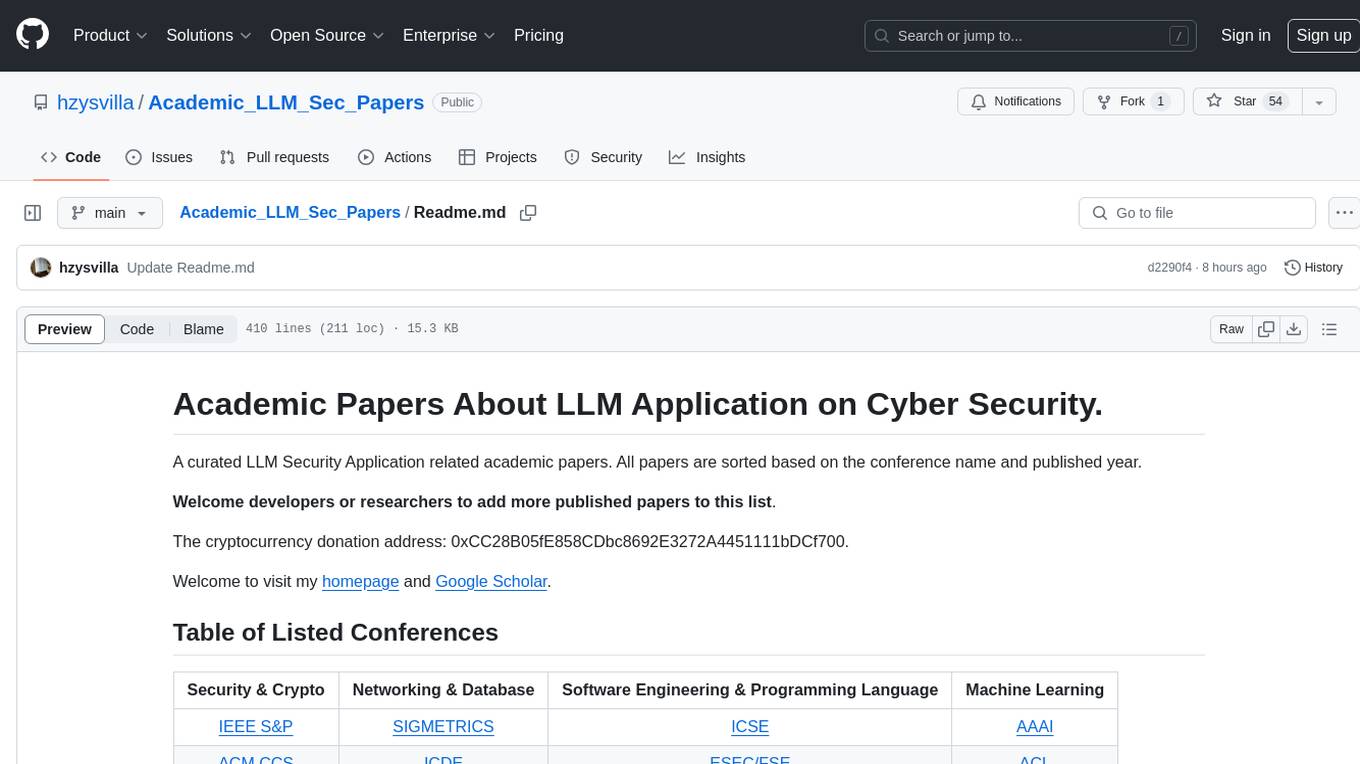
Academic_LLM_Sec_Papers
Academic_LLM_Sec_Papers is a curated collection of academic papers related to LLM Security Application. The repository includes papers sorted by conference name and published year, covering topics such as large language models for blockchain security, software engineering, machine learning, and more. Developers and researchers are welcome to contribute additional published papers to the list. The repository also provides information on listed conferences and journals related to security, networking, software engineering, and cryptography. The papers cover a wide range of topics including privacy risks, ethical concerns, vulnerabilities, threat modeling, code analysis, fuzzing, and more.
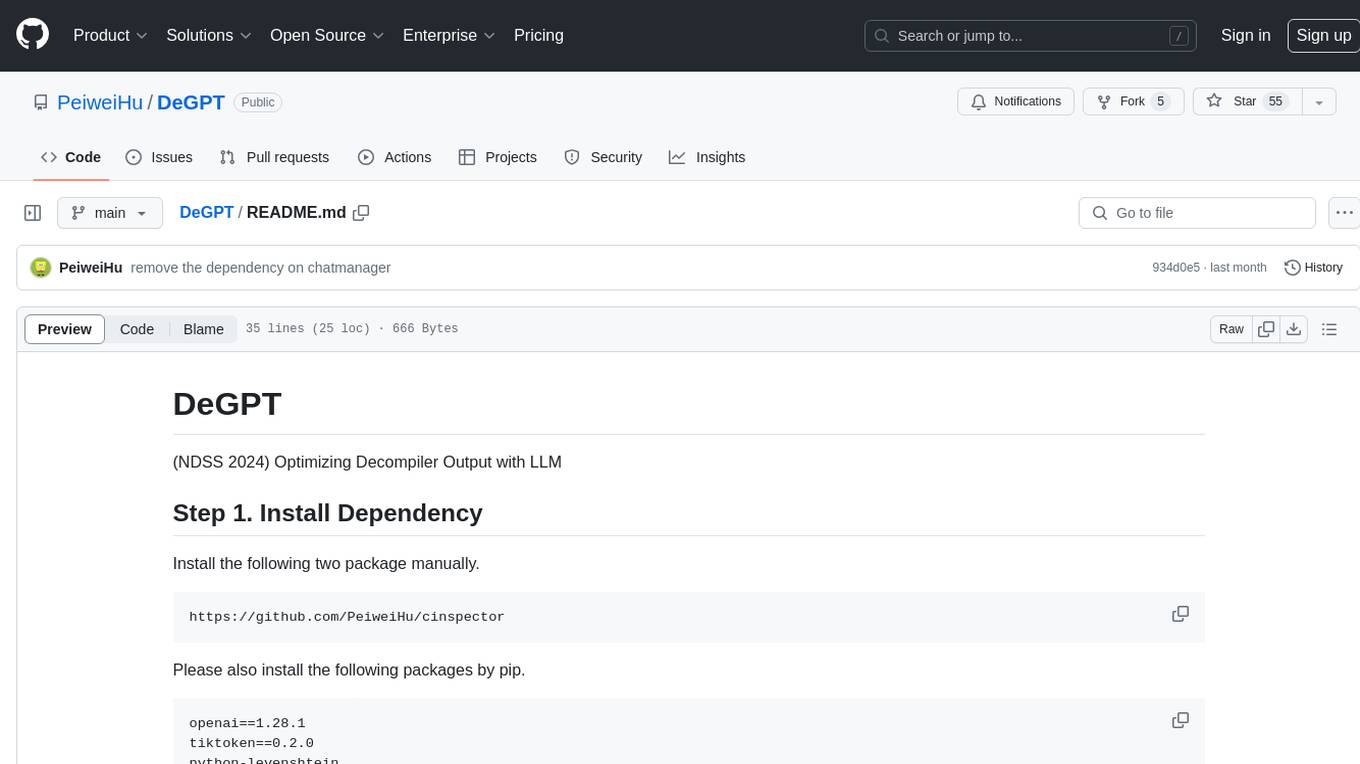
DeGPT
DeGPT is a tool designed to optimize decompiler output using Large Language Models (LLM). It requires manual installation of specific packages and setting up API key for OpenAI. The tool provides functionality to perform optimization on decompiler output by running specific scripts.






